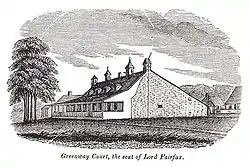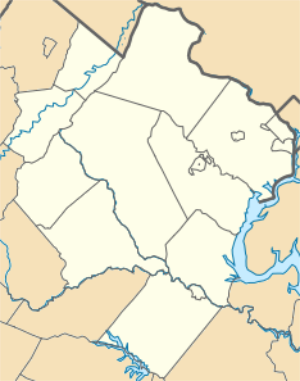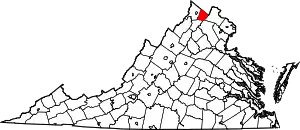Greenway Court, Virginia
Greenway Court is a historic country estate near White Post in rural Clarke County, Virginia. The property is the site of the seat of the vast 18th-century land empire of Thomas Fairfax, 6th Lord Fairfax of Cameron (1693-1781), the only ennobled British colonial proprietor to live in one of the North American colonies. The surviving remnants of his complex — a later replacement brick house and Fairfax's stone land office — were designated a National Historic Landmark in 1960.[2][4]
Greenway Court | |
 Early-19th-century engraving of the main house at Greenway Court | |
   | |
| Location | 1 mi. S of White Post on VA 658, White Post, Virginia |
|---|---|
| Coordinates | 39°2′46″N 78°7′9″W |
| Area | 5 acres (2.0 ha) |
| Built | 1748 |
| NRHP reference No. | 66000829 |
| VLR No. | 021-0028 |
| Significant dates | |
| Added to NRHP | October 15, 1966[1] |
| Designated NHL | October 9, 1960[2] |
| Designated VLR | September 9, 1969[3] |
Description
Greenway Court is located down a long private drive on the west side of White Post Road south of the village of White Post. The property now consists of about 5 acres (2.0 ha), although it was in the 18th century at the center of landholdings in excess of 5 million acres (20,000 km2). Its principal feature today is a brick farmhouse built in 1828, the original plantation house having been demolished c. 1834. The main historic structure surviving from the period of the Fairfax residency is the Land Office, a c. 1762 single-story gable-roofed limestone structure, and there is also a timber smokehouse dating to the 18th century.[4]
History
.jpg.webp)
Greenway Court was the center of the "Northern Neck Proprietary" or "Fairfax Grant", which passed to Thomas Fairfax, 6th Lord Fairfax of Cameron from his mother's family, the Culpepers, who had taken proprietorship of the land in 1673. Fairfax laid out the Greenway Court estate in 1747, intending it to be a much larger establishment than it became. The main house was a 1-1/2 story timber structure with long sloping roofs and corbelled brick chimneys. It was originally intended to house the land steward, but it was occupied by Fairfax with his nephew, Thomas Bryan Martin, until his death in 1781. Fairfax employed a young George Washington as a surveyor on his extensive land holdings.[4]
Abandoned, the roof of the main house at Greenway Court collapsed in 1834, after which the structure was pulled down.
A visit to this estate is the subject of "A Night at Greenway Court," an 1896 short story by Willa Cather.
Unincorporated community
Greenway Court is used as a name to describe the unincorporated community in which the former estate is located.[5]
See also
References
- "National Register Information System". National Register of Historic Places. National Park Service. January 23, 2007.
- "Greenway Court". National Historic Landmark summary listing. National Park Service. Archived from the original on 2007-12-31. Retrieved 2008-04-12.
- "Virginia Landmarks Register". Virginia Department of Historic Resources. Retrieved 5 June 2013.
- Stephen Lissandrello (March 15, 1975). "National Register of Historic Places Inventory-Nomination: Greenway Court" (pdf). National Park Service. Cite journal requires
|journal=(help) - "Greenway Court, Virginia". Geographic Names Information System. United States Geological Survey.
External links
| Wikimedia Commons has media related to Greenway Court. |
- Greenway Court, Clarke County, one photo at Virginia DHR
- Historic American Buildings Survey (HABS) No. VA-332, "Greenway Court, Estate Office, State Route 658 vicinity, White Post vicinity, Clarke County, VA", 7 photos, 2 data pages, supplemental material
- HABS No. VA-108, "Greenway Court", supplemental material
- HABS No. VA-108-A, "Greenway Court, Outbuilding", 4 photos
- HABS No. VA-108-B, "Greenway Court, Powder House", 6 photos, 4 measured drawings, 2 data pages


